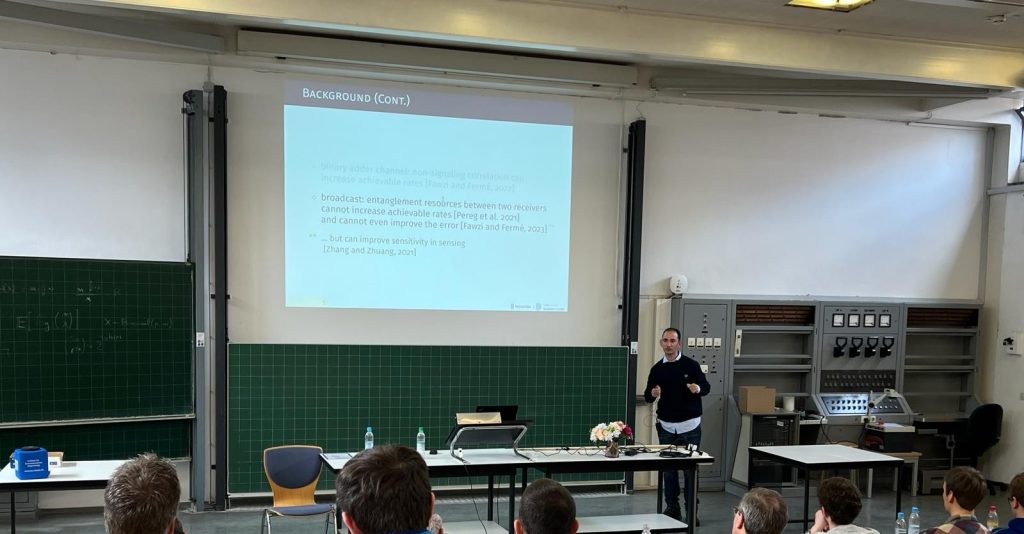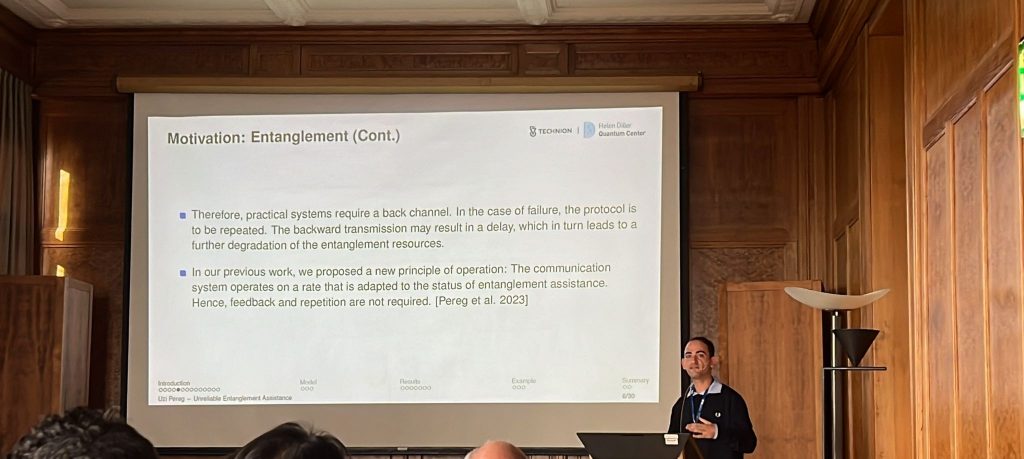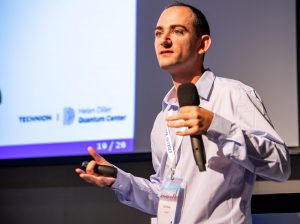
Speaker: Uzi Pereg
Communication over a fully quantum relay channel is considered. We establish three bounds based on different coding strategies, i.e., partial decode-forward, measure-forward, and assist-forward. Using the partial decode-forward strategy, the relay decodes part of the information, while the other part is decoded without the relay’s help. Based on our partial decode-forward bound, the capacity is determined for Hadamard relay channels. In the measure-forward coding scheme, the relay performs a sequence of measurements and then transmits a compressed representation. At last, the assist-forward bound is based on a new approach, whereby the transmitter sends the message to the relay and simultaneously generates entanglement assistance between the relay and the destination receiver. Subsequently, the relay can transmit with rate limited entanglement assistance.
Speaker: Husein Natur
Quantum coordination is considered in networks with classical and quantum links. We begin with networks with classical links, and characterize the generation of separable and classical quantum correlations in three primary models: 1) a two-node network with limited common randomness (CR), 2) a no communication network, and 3) a broadcast network, which consists of a single sender and two receivers. We establish the optimal tradeoff between the classical communication and CR rates in each setting, thus characterizing the minimal resources for simulating classical-quantum correlations.
Next, we consider coordination in networks with quantum links. We study the following models: 1) a cascade network with limited entanglement, 2) a broadcast network, and 3) a multiple-access network with two senders and a single receiver. We establish the optimal tradeoff between quantum communication and entanglement rates in each setting, characterizing the minimal resources for entanglement coordination. The examples demonstrate that coordination of entanglement and coordination of separable correlations behave differently. At last, we show the implications of our results on nonlocal games with quantum strategies.
Speaker: Meir Lederman
Secure communication is considered with unreliable entanglement assistance, due to one of two reasons: Interception or loss. We consider two corresponding models. In the first model, Eve may intercept the entanglement resource. In the second model, Eve is passive, and the resource may dissipate to the environment beyond her reach. The operational principle of communication with unreliable entanglement assistance is to adapt the transmission rate to the availability of entanglement assistance, without resorting to feedback and repetition. We derive achievable rates for both models, subject to a maximal error criterion and semantic security. In addition, we derive a multi-letter secrecy capacity formula for the special class of degraded channels. As an example, we consider the amplitude damping channel. Under interception, time division is not necessarily possible, and the boundary of our achievable region is disconnected. In the passive model, our rate region outperforms time division.
Speaker: Elyakim Zlotnick
The standard security approach in communications aims to prevent a malicious eavesdropper from retrieving the information that is transmitted to the legitimate receiver. However, privacy and safety concerns may require an even stronger security criterion. In covert communication, not only the information is kept secret, but the transmission itself must be concealed from detection by an adversary. Despite the severity of such limitations, it is possible to communicate O(√n) bits of information in a block of n transmissions via a noisy channel, in all but trivial scenarios. That is, the sender (Alice) can use an error-correction code to map O(√n) information bits into codewords of length n, such that the legitimate receiver (Bob) can decode the information reliably, while the adversary (Willie) cannot detect the transmission. Previously, it was shown that pre-shared entanglement can improve the scaling to O(√n logn ) information bits in the continuousvariable setting, for Gaussian bosonic channels (Gagatsos et al., 2020).
In some information-theoretic frameworks, coding scales are larger in continuous-variable models, compared to the discrete-variable setting. Therefore, until now, it was not clear whether the logarithmic factor can be achieved in discrete-variable covert communication. Here, we study covert communication via the qubit depolarizing channel with entanglement assistance, in different scenarios. In the canonical representation of the qubit depolarizing channel, Bob receives a single qubit, while two qubits dissipate to the environment. We consider three scenarios. If the adversary has full access to the environment (Scenario 1), then we show that covert communication is impossible. On the other hand, if the adversary receives the first qubit, i.e., “half” the environment (Scenario 2), then covert communication turns out to be trivial. The most interesting case is when the adversary receives the other half (Scenario 3). In this case, the number of information bits that can be transmitted, reliably and covertly, scales as O(√n logn ) when entanglement assistance is available to Alice and Bob, as opposed to O(√n) information bits without assistance. Thereby, we establish that the logarithmic performance boost is not reserved to continuous-variable systems.
 Speaker: Prof. Uzi Pereg
Speaker: Prof. Uzi Pereg
Communication over a classical multiple-access channel (MAC) with entanglement resources is considered, whereby two transmitters share entanglement resources a priori before communication begins. Leditzky et al. (2020) presented an example of a classical MAC, defined in terms of a pseudo telepathy game, such that the sum rate with entangled transmitters is strictly higher than the best achievable sum rate without such resources. Here, we establish inner and outer bounds on the capacity region for the general MAC with entangled transmitters, and show that the previous result can be obtained as a special case. It has long been known that the capacity region of the classical MAC under a message-average error criterion can be strictly larger than with a maximal error criterion (Dueck, 1978).
We observe that given entanglement resources, the regions coincide. Furthermore, we address the combined setting of entanglement resources and conferencing, where the transmitters can also communicate with each other over rate-limited links. Using superdense coding, entanglement can double the conferencing rate.
Speaker: Prof. Uzi Pereg

Speaker: Prof. Uzi Pereg
Quantum communication has seen rapid development in the last decade, in both practice and theory. Entanglement resources are instrumental in a wide variety of quantum network frameworks. In particular, entanglement assistance can increase transmission rates substantially. Unfortunately, entanglement is a fragile resource that is quickly degraded by decoherence effects. To generate entanglement for optical communication, the transmitter first prepares an entangled photon pair locally, and then transmits a photon to the receiver through an optical fiber or free space. Without feedback, the transmitter does not know whether the entangled photon has reached the receiver.
The present work introduces a new model of unreliable entanglement assistance, whereby the communication system operates whether entanglement assistance is present or not. While the sender is ignorant, the receiver knows whether the entanglement generation was successful. In the case of a failure, the receiver decodes less information. In this manner, the effective transmission rate is adapted according to the assistance status. Regularized formulas are derived for the classical and quantum capacity regions with unreliable entanglement assistance, characterizing the tradeoff between the unassisted rate and the excess rate that can be obtained from entanglement assistance.
 Speaker: Prof. Uzi Pereg
Speaker: Prof. Uzi Pereg
We consider communication over a quantum broadcast channel with cooperation between the receivers. Through this setting, we provide an information-theoretic perspective on quantum repeaters. First, we observe that entanglement resources alone do not increase the achievable communication rates. By comparison with the recent results by Leditzki et al. (2020), this observation reveals a violation of the BC-MAC duality between the broadcast channel with two receivers and the multiple-access channel with two transmitters. The next form of cooperation addressed is classical conferencing, where Receiver 1 can send classical messages to Receiver 2. We provide a regularized characterization of the classical capacity region and establish a single-letter formula for the special class of Hadamard broadcast channels.
Given both classical conferencing and entanglement resources, Receiver 1 can teleport a quantum state to Receiver 2. This setting is intimately related to quantum repeaters, as the sender, Receiver 1, and Receiver 2 can be viewed as the transmitter, the repeater, and the destination receiver, respectively. When Receiver 1’s sole purpose is to help the transmission to Receiver 2, the model reduces to the quantum primitive relay channel. We derive lower and upper bounds for each setting; and conclude with observations on the tradeoff between repeater-aided and repeaterless communication, and the bottleneck flow behavior of quantum repeaters.
Speaker: Prof. Uzi Pereg
Communication over a quantum channel that depends on a quantum state is considered when the encoder has channel side information (CSI) and is required to mask information on the quantum channel state from the decoder. A full characterization is established for the entanglement-assisted masking equivocation region with a maximally correlated channel state, and a regularized formula is given for the quantum capacity-leakage function without assistance. For Hadamard channels without assistance, we derive single-letter inner and outer bounds, which coincide in the standard case of a channel that does not depend on a state.
Speaker: Prof. Uzi Pereg
We study the arbitrarily varying broadcast channel (AVBC) when the state information is available at the transmitter in a causal manner. We establish the inner and outer bounds on both the random code capacity region and the deterministic code capacity region with degraded message sets. The capacity region is then determined for a class of channels satisfying a condition on the mutual information between the strategy variables and the channel outputs. As an example, we consider the arbitrarily varying binary symmetric broadcast channel. We show the cases where the condition holds and, hence, the capacity region is determined and other cases where there is a gap between the bounds. This gap shows that the minimax theorem does not hold for rate regions.
Speaker: Prof. Uzi Pereg
We consider the arbitrarily varying Gaussian relay channel with sender frequency division. We determine the random code capacity, and establish lower and upper bounds on the deterministic code capacity. It is observed that when the channel input is subject to a low power limit, the deterministic code capacity may be strictly lower than the random code capacity, and the gap vanishes as the input becomes less constrained. A second model addressed in this paper is the general case of primitive arbitrarily varying relay channels. We develop lower and upper bounds on the random code capacity, and give conditions under which the deterministic code capacity coincides with the random code capacity, and conditions under which it is lower. Then, we establish the capacity of the primitive counterpart of the arbitrarily varying Gaussian relay channel with sender frequency division. In this case, the deterministic and random code capacities are the same.
Speaker: Prof. Uzi Pereg
Two models of an arbitrarily varying channel (AVC) are studied; both are relevant to modern networks under jamming attacks by an adversary or a hacker. The arbitrarily varying broadcast channel is considered when state information is available at the transmitter in a causal manner. Inner and outer bounds are established, on both the random code capacity region and the deterministic code capacity region with degraded message sets. The form of the bounds raises the question whether the minimax theorem can be generalized to rate regions, i.e. whether the order of the intersection over state distributions and the union over Shannon strategies can be interchanged. A sufficient condition is given, under which this assertion holds and the random code capacity region is determined. As an example, the arbitrarily varying binary symmetric broadcast channel is examined, showing that there are cases where the condition holds, hence the capacity region is determined, and other cases where there is a gap between the bounds. The gap implies that the minimax theorem does not always hold for rate regions.
In the second part of the talk, a new model is introduced, namely, the arbitrarily varying relay channel. The results include the cutset bound, decode-forward bound and partial decode-forward bound on the random code capacity, which require modification of the usual methods for the AVC to fit the block Markov coding scheme. The random code capacity is further determined for special cases. Then, deterministic coding schemes are considered, and the deterministic code capacity is derived under certain conditions, for the degraded and reversely degraded relay channel, and the case of orthogonal sender components. The following question is addressed: If the encoder-decoder and encoder-relay marginals are both symmetrizable, does that necessarily imply zero capacity? We show and explain why the answer is no. The random code capacity is determined for the arbitrarily varying Gaussian relay channel with sender frequency division, and the deterministic code capacity is bounded using the techniques of Csisz\’ar and Narayan’s 1991 paper on the Gaussian AVC. It is observed that the gap vanishes as the input becomes less constrained. It is commonly believed that the primitive relay channel “captures most essential features and challenges of relaying, and thus serves as a good testbed for new relay coding techniques” (Kim, 2007). It is observed that in the arbitrarily varying case, this may no longer be true.